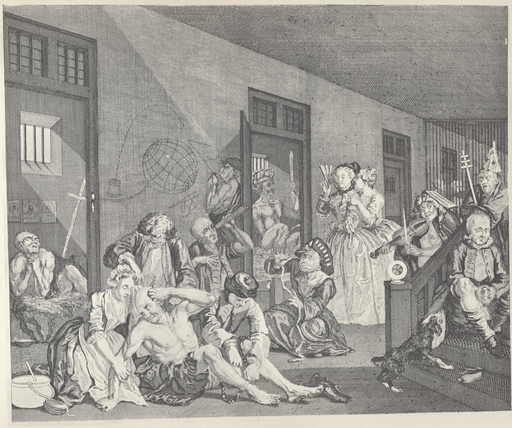"And kept I long heaven's watch for this,Repressing her romantic and sexual urges, Melville's passionate astronomer Urania makes herself crazy. Eventually she recognizes her own self delusion, though she does not welcome the truth and will even regret the hard, irreversible experience of disillusionment. In the stanza from the poem "After the Pleasure Party" (first published in the 1891 volume Timoleon) quoted above, the figure of the constellation "Cassiopea in Golden Chair" represents the speaker's obsessive pursuit of astronomy as a grandiose hallucination or "dream" of scientific glory. As Urania now recognizes, the intellectual lure of astronomy kept her from seeing the imprisoned lunatic she herself was becoming. Cassiopea symbolizes Urania's exalted, stellar vision of herself as royalty, while the "idiot crowned with straw" represents her actual state of self-imposed isolation and mental instability.
Contemning love, for this, even this?
O terrace chill in Northern air,
O reaching ranging tube I placed
Against yon skies, and fable chased
Till, fool, I hailed for sister there
Starred Cassiopea in Golden Chair.
In dream I throned me, nor I saw
In cell the idiot crowned with straw."
--from the poem After the Pleasure Party by Herman Melville
Melville's images of astronomy and mental illness in "After the Pleasure Party" strikingly correspond to particular images in William Hogarth's The Madhouse, the eighth and last painting in the series A Rake's Progress.
"The eight paintings in William Hogarth's A Rake's Progress (1733) tell the story of Tom Rakewell, a young man who follows a path of vice and self-destruction after inheriting a fortune from his miserly father. It was Hogarth's second 'modern moral subject', and followed the hugely successful A Harlot's Progress (1730).
The series is principally known through the engravings made by Hogarth from his paintings in 1735." --Sir John Soane's MuseumAlso as described at the great Soane Muesum website, inmates of Hogarth's madhouse
"include a tailor, a musician, an astronomer and an archbishop. In the door to one of the cells is a man who thinks he is a king - he is naked and carries a straw crown and sceptre.
Like the real Bedlam, Hogarth's Madhouse is open to the public. Two fashionable ladies have come to observe the poor suffering lunatics as one of the sights of the town." --Soane Muesum
In Melville's poem, Urania oddly depicts her telescope as a "reaching ranging tube" pointed skyward. In the center of Hogarth's painting, the mad astronomer squints through a homemade tube of a telescope, which looks like a rolled-up newspaper. The mad astronomer of Hogarth's engraving has even been characterized as a "victim of science":
"In the hospital science has claimed two victims. The fellow peering at the ceiling through a roll of paper which he imagines to be a telescope is an astronomer. Behind him the fellow who has drawn the ship, mortar and shot, earth, moon and various geometric patterns is attempting to discover a scheme for calculating longitude."Like Melville's Urania, Hogarth's deluded astronomer is not able to see the ludicrous figure in the cell who wears a straw crown and has, again like Urania, proudly throned himself. In manuscript versions of "After the Pleasure Party," discarded alternatives for "idiot" included "mad one"; "elated mad one"; and "loon." (As shown in editorial notes for the Northwestern-Newberry edition of Melville's Published Poems, pages 773-4.)
--Darvill's Rare Prints
The moral message or "tendency" that Rev. John Trusler finds in Hogarth's Madhouse portraits gets remarkably near to the meaning of Melville's figures of the astronomer's telescope and crowned lunatic in "After the Pleasure Party":
By these expressive figures we are given to understand that such is the misfortune of man, that while, perhaps, the aspiring soul is pursuing some lofty and elevated conception, soaring to an uncommon pitch, and teeming with some grand discovery, the ferment often proves too strong for the feeble brain to support, and lays the whole magazine of notions and images in wild confusion. --Works of William Hogarth (London, 1833)
 |
| A Rake's Progress, Plate 8 from The genius of William Hogarth or Hogarth's Graphical Works William Hogarth via Wikimedia Commons |
"...a folio volume of Hogarth lay open, with a cocoa-nut shell of some musty preparation capsized among the miscellaneous furniture of the Rake's apartment, where that inconsiderate young gentleman is being measured for a coat." --OmooIn Moby-Dick, Melville through Ishmael humorously criticizes the sea monster in Hogarth's Perseus Descending as one of many bad monstrous pictures of whales.
Later: Melville's Wellingborough Redburn owns an "old quarto Hogarth." And in White-Jacket, chapter 90 opens with an elaborate appreciation of the fifth plate from Hogarth's Industry and Idleness series:
"The gallows and the sea refuse nothing," is a very old sea saying; and, among all the wondrous prints of Hogarth, there is none remaining more true at the present day than that dramatic boat-scene, where after consorting with harlots and gambling on tomb-stones, the Idle Apprentice, with the villainous low forehead, is at last represented as being pushed off to sea, with a ship and a gallows in the distance. But Hogarth should have converted the ship's masts themselves into Tyburn-trees, and thus, with the ocean for a background, closed the career of his hero. It would then have had all the dramatic force of the opera of Don Juan, who, after running his impious courses, is swept from our sight in a tornado of devils. -- White-Jacket, The Manning of Navies
 |
| William Hogarth - Industry and Idleness, Plate 5; The Idle 'Prentice turn'd away, and sent to Sea From The genius of William Hogarth or Hogarth's Graphical Works via Wikimedia Commons |
- Where to find lines traced under an image of Amor threatening
https://melvilliana.blogspot.com/2017/08/where-to-find-lines-traced-under-image.html



Melville may have taken the golden chair of Cassiopeia from Elijah Burritt's Geography of the Heavens (when I tried to italicize that title, things went south.). The gold color seems to be part of a memory devise. Astronomers did not use it.
ReplyDelete